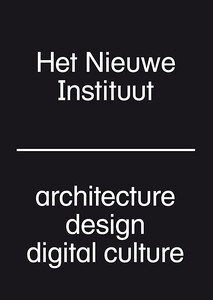At the 16th Venice Architecture Biennale
May 25, 2018, 4:30pm
Giardini
Venice
Italy
Book launch Work, Body, Leisure with Nick Axel, Marina Otero Verzier and book contributors including Amal Alhaag, AMO, Henk Ovink, Manuel Shvartzberg, Nathalie de Vries, and Femke Herregraven. Response by Floris Alkemade.
Published in conjunction with the Dutch Pavilion at the 16th International Architecture Exhibition of the Venice Biennale, the book Work, Body, Leisure seeks to foster new forms of creativity and responsibility within the architectural field in response to emerging technologies of automation.
The essays contained in this volume chart a journey to spaces in the Netherlands—a testing ground where the future of labor has been and continues to be reimagined—and beyond; across offices, playgrounds, farms, factories and virtual spaces, windows, beds and doors through which bodies are categorized and transformed. Meticulously designed, the Dutch landscape is the result of centuries of human-machine enterprises. So is its organization of society. An emphasis on work and discipline over leisure also manifests in its architecture, from the scale of the territory to that of the bed.
The flat horizon, managed and protected by flood control systems, and the regularity of land lots are reinforced by that of the greenhouses that sit on top; enclosures of sublime beauty where the productivity of the ground is maximized by automated technologies. Inside these “new Gardens of Eden,” as coined by AMO, plants grow unrestricted by exterior conditions, and soon, human labor.
These climate-controlled interior spaces seem to offer endless possibilities for experimentation outside of the greenhouse typology as well. The flexible office, here reimagined by MVRDV’s Nathalie de Vries, has become an open field of shared tables where workers no longer have a reserved seat, but rather reinvent their personal workspace every morning. Assisting these ever-changing communal spaces, walls of lockers present the systemic counter image of individualized, closed worlds for the administration of private identities and belongings. Populating factories, co-working spaces, as well as the leisure-oriented architecture of the changing room, the locker is an interface between the laboring and the non-laboring self, if any distinction between the one and the other remains today.
The domestic space is not exempt from labor’s sprawl. The bed, as a site for production—as Beatriz Colomina argues—becomes a “fucktory,” a notion that, perhaps, finds its more prominent urban response in the Netherlands. Amsterdam’s red-light district epitomizes the architectures of sex work and how it has become typologically defined and legally normalized, including the “afwerkplek” (drive-in infrastructures for sex), and window-brothels that have been gradually transformed into studios for creative practitioners and—as some reports predict—might soon been taken over by robot sex workers.
This architecture for the transformation of a body into a worker, also has a door. Amal Alhaag focuses on The Door(s) of No Return, a symbol of the slave trade. The Door(s) are an architecture for the brutal displacement, disposal, and transformation of bodies, languages, identities, belonging; sites that shape the realities of black beings. The space between the Door(s) and the ocean is not only a site for the engineered, racialized body, but also one through which it is possible to read the ways in which evolving notions of labor have categorized and defined bodies at particular moments in time, as well as the legal, cultural, and technical infrastructures that enable their exploitation.
By reflecting on a spectrum of spaces and theoretical viewpoints, Work, Body, Leisure seeks to offer visions that could be deployed in the reshaping of labor structures, and ultimately, our capacity to redesign them according to a different set of ethical principles. The contributions by Amal Alhaag, AMO, Pier Vittorio Aureli & Maria Shéhérazade Giudici, Jonathan Beller, Beatriz Colomina, Silvia Federici, Ayesha Hameed, Femke Herregraven, Het Nieuwe Instituut, Markus Krajewski, Egbert Alejandro Martina, Francesco Marullo, Victor Muñoz Sanz, Constant Nieuwenhuys, Simone C. Niquille, Henk Ovink, Paul B. Preciado, Manuel Shvartzberg, Ekim Tan, Nathalie de Vries, Mark Wigley, Annemarie de Wildt and Marina van Zuylen, address spatial configurations, living conditions, and notions of architecture itself that could engender disruptive changes in our current Cartesian landscape designed for the exploitation of all bodies.
Editor: Marina Otero Verzier; Managing Editor: Nick Axel; Graphic Design: Hans Gremmen; Published by Het Nieuwe Instituut and Hatje Cantz Verlag GmbH; English edition, 320 pages, 217 illustrations; ISBN 978-3-7757-4425-6
Selected essays will be published in installments in the WORK, BODY, LEISURE web dossier, starting with the introduction by Marina Otero Verzier, a lecture by Constant Nieuwenhuys, a contribution from research and design studio AMO and essays by Paul Preciado and Amal Alhaag.
Exhibition WORK, BODY, LEISURE
WORK, BODY, LEISURE is also the theme of the Dutch contribution to the Biennale Architettura 2018. The project, commissioned by Het Nieuwe Instituut, is curated by Marina Otero Verzier and includes contributions by architects, artists, designers, theorists and musicians selected by the curatorial team and through a number of Open Calls.
Contributors: Amal Alhaag, Beatriz Colomina, Marten Kuijpers, Victor Muñoz Sanz, Simone C. Niquille and Mark Wigley.
Extended Program in Partnership with Creative Industries Fund NL: Jane Chew and Matthew Stewart; Northscapes Collective (Taneha K. Bacchin, Hamed Khosravi and Filippo laFleur); Noam Toran, Florentijn Boddendijk and Remco de Jong; Giuditta Vendrame, Paolo Patelli and Giulio Squilacciotti and Liam Young.


